The award-winning makeover of a ‘higgledy-piggledy’ manor in the Snowies
It once had servants scuttling about. Now, after a thoroughly modern renovation, this grand manor is a home for four.
By Luke Slattery
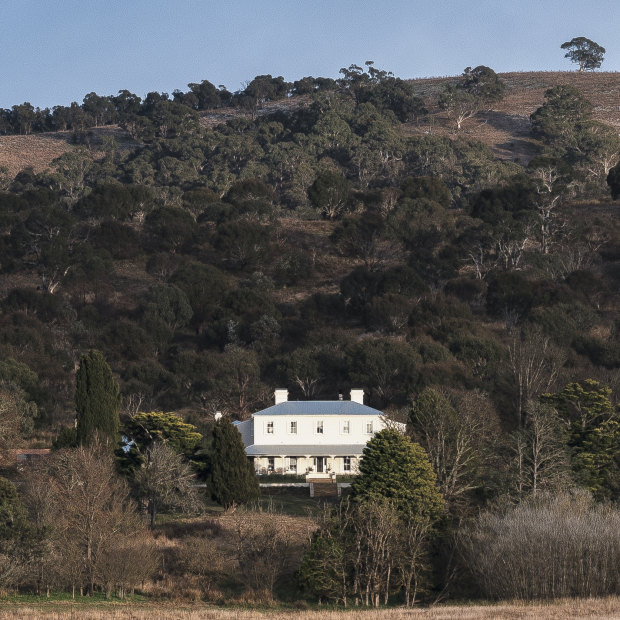
The Estate, a grand though rambling two-storey house set in undulating high country of the Snowy Monaro region.Credit: Tom Ferguson
Seared into Luke Moloney’s memory is his first glimpse of the isolated 1880s villa that has consumed nine years of his professional life. The Sydney-based architect had taken a six-hour drive south by south-west to the Snowy Monaro region with a client, arriving well after dark. “It was quite late and as we drove down the dirt road to reach the homestead, it was utter blackness,” he recalls of the 2014 trip. “I felt like I was disappearing into the bush, perhaps never to return.”
In the distance he spied a tile of gilt light – one illuminated upstairs window – hanging in the night sky: “It was quite hair-raising, at the very least mysterious.” Moloney woke the next morning to find himself in The Estate, a grand though rambling two-storey house set in undulating high country. “To call the house dilapidated would be an overstatement,” he says, “but it was certainly atmospheric. And romantic! The rooms were all higgledy-piggledy. The place was eccentrically arranged. But it was full of possibilities.”
Moloney was travelling with George, a Sydney lawyer and husband of Sally, a schoolteacher and old friend from university. The couple had just bought the homestead and its surrounding 20 hectares for $780,000. They called Moloney, who had recently decided to strike out on his own after a stint with feted Sydney practice Smart Design Studio. This, together with a project in Bowral several hours’ drive away, was to be the first commission of his own studio.
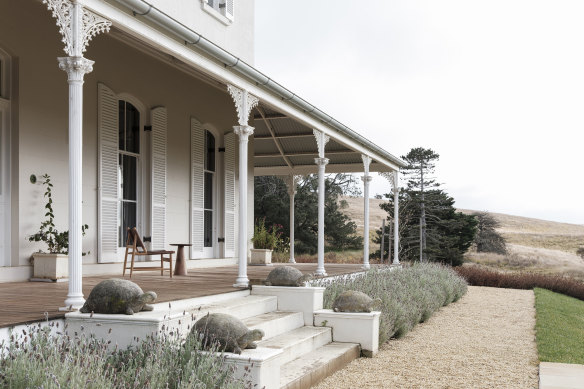
The villa’s main dwelling is skirted by a wide verandah.Credit: Tom Ferguson
What George and Sally had got for their money was a gracious villa with, at the rear, two wings set at right angles to the main dwelling and forming a courtyard or compound, as well as a couple of characterful cottages. One of the rear wings was a set of children’s bedrooms, the other, servants’ quarters.
“My first job was to translate this once-grand old home for a contemporary way of living that would retain its relevance way into the future,” Moloney recalls. “But at the same time, the clients didn’t want anything too clean, too neat. If the afternoon light raked across a wall, they wanted to see the imperfections in it.”
One of the main concessions to modern living was a large kitchen with a floating island bench topped in Carrara marble – a design change that registers something of a gastronomic revolution. No longer a form of specialised labour, cooking has become entertainment – domestic theatre. No longer served by domestic staff, the meal is “plated” by family and friends.
Long before it received the last lick of fresh white paint, it had managed to set the architectural world abuzz.
During the year-long renovation and reconstruction of the main two-storey house – skirted by an elegant and deeply shaded cast-iron verandah – the clients stayed in simple local cottages. After a regrouping pause, the team – architect, clients and builders – tackled the two-storey servants’ quarters. This wing has been transformed into a double-height living room with a raised mezzanine library and workspace.
The most dramatic feature of this space – and in Moloney’s view, the entire house – is a coiling black steel staircase that links the raised office-library to the ground floor. After another pause, this time for three years, the old children’s bedroom extension was transformed into a guest wing.
With the completion of the guest wing last Christmas, The Estate is no longer a work in progress. Although long before it received the last lick of fresh white paint, it had managed to set the architectural world abuzz. For his work on it, Moloney reeled in the Heritage Creative Adaptation prize at the 2023 NSW Architecture Awards. It was shortlisted the same year in the national architecture awards in a heritage category that included the refurbished Sydney Opera House Concert Hall – the short-odds favourite and eventual winner.
Luke Moloney is no stranger to the winners’ circle. Before The Estate, he worked as one of the project architects for Smart Design Studio’s Indigo Slam. Built for Sydney philanthropist and gallerist Judith Neilson as a grand inner-Sydney residence, Indigo Slam set the gold standard for Australian residential architecture in 2016 by winning the prestigious Robin Boyd Award. Beyond the superficial similarity of scale and drama, Indigo Slam and The Estate are entirely different creatures. The former’s grandeur is sculptural, a touch bombastic and thoroughly urban. The Estate, in contrast, is striking yet largely understated, and it’s not only rural – it’s remote, 45 minutes’ drive from the nearest town.
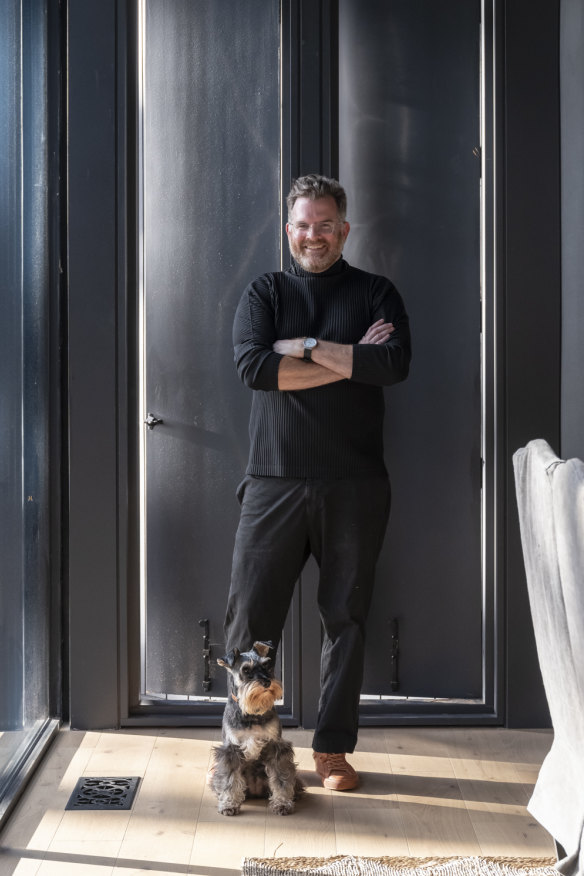
Architect Luke Moloney with Lotti, his schnauzer.Credit: Tom Ferguson
Sally and George had spent a decade in the United Kingdom before returning to Sydney to raise their two sons and reconnect with relatives. But the desire for a small-town life for the boys had them looking for wider horizons, cleaner air, less commuter traffic and a connected community. “George is a country boy at heart and he wanted that experience for the boys,” explains Sally. “I was raised in Newcastle and know nothing about country life other than that I don’t like snakes.”
Living in the UK had deepened their appreciation of historic buildings and The Estate, which had been in the hands of the same family of Scottish immigrant graziers since the late 19th century, seemed to have their name on it. The homestead has the unique quality of being a Victorian building with the personality of the earlier Georgian era – an exercise in nostalgia before the term was popularised. Where late Victorian architecture is highly decorative – think Melbourne’s Royal Exhibition Building and Sydney’s Queen Victoria Building – Georgian style is plain, restrained, neoclassical and elegant.
The irony – of which both the architect and client are well aware – is that the older Georgian architecture dovetails nicely with the austerity of modernism. “Definitely that simplicity appealed,” reflects Sally. “The building’s Georgian bones made it easier to imagine something that was classical and at the same time contemporary.”
‘We’d often find ourselves in a position where two of us would oppose one, and we’d thrash it out.’
Co-owner, Sally
Another peculiarity of the project is that the original 1880s homestead wasn’t heritage-listed – although a smaller cottage on the property was. As a result of Moloney’s work, however, The Estate now carries a heritage listing: a rare case of a contemporary renovation and adaptation revealing, Cinderella-style, the striking beauty that had been hidden all along.
Simplification was a large part of the architect’s approach. Says Moloney: “When we found it, the building bore all the marks of a former life defined by an army of domestic staff needed to keep the place going, and they needed not only their own bedrooms but funny passages and eccentric stairways to serve the family, and then over time, funny bathrooms and offices had been stuffed into available spaces. We had to excise some of the more eccentric parts and put back a more classical arrangement of rooms and spaces to make it true to how it was meant to be, while bringing it up to speed with the owners’ needs.”
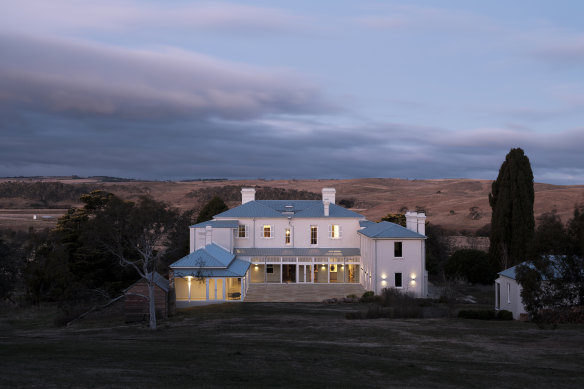
The homestead in its Monaro setting – a landscape that’s “still not fully appreciated”, says a former owner.Credit: Tom Ferguson
One of time’s eccentric accretions was a room with a window and no door. “It had been bricked up some time in the past and we had no idea what we’d find in there,” recalls the architect. “Would there be a skeleton, literally, in the closet? For five whole years, it was giving everybody the absolute willies. It was almost a disappointment to find it skeleton-free.” When Moloney visits, he bunks down in this former mystery room. “It’s always a wrench to leave,” he says a little wistfully. “To leave that powerful landscape.”
Due in part to Moloney’s long and still-standing friendship with Sally, many of the early design decisions were made collaboratively. “We’d often find ourselves in a position where two of us would oppose one, and we’d thrash it out,” she says. “Luke and I had a particular carpet we wanted but George outright refused, and so we went away and found a compromise that turned out to be a better choice. In fact, most of our decisions were strengthened in this way. But then, because the building was done in stages, we reflected between stage one and two that we should have come to the party on some of the things Luke had wanted – some marble splashbacks in the kitchen, for example. In the second stage, the library wing, and the third, the guest wing, we were a little more hands-off. An exception was all the family practicalities – bringing the shopping in, ironing and laundry. I usually got my way on those things.”
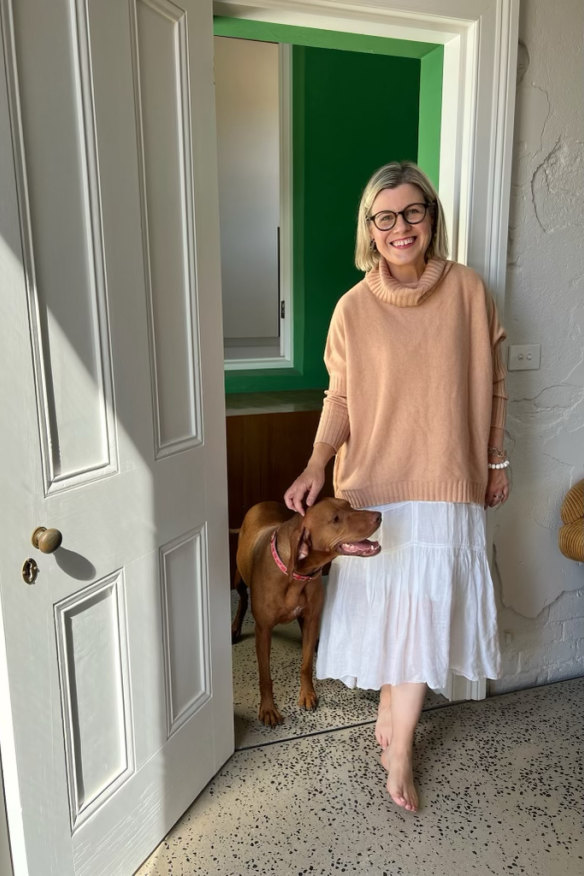
Sally, one of the manor’s owners, with Ruby, her vizsla. “The clients didn’t want anything too clean, too neat,” architect Moloney says. “If the afternoon light raked across a wall, they wanted to see the imperfections in it.”Credit: Alice Shannon
The building has a large solar array and its palatial four-metre-high ceilings called for a robust heating solution – particularly in a challenging winter climate. Geothermal bores made the dream of under-floor heating a reality.
“It gets bloody cold down there and you could see that some of the spaces had evolved to block out draughts,” says Moloney. “Once we solved the heating problems, we could also open up the spaces and allow for a better flow between rooms.” The interior spaces are tied together with a muted palette of white, black and grey. The polished floorboards, grand 19th-century staircases and original marble fireplaces add warmth, while high-end European lighting brings a touch of wow.
The Estate is an intelligent and refined piece of bridge-building – linking the past with the present and an anticipated future. But the continuity is as much human as architectural. Former owners Rob and Henny Campbell, descendants of the property’s pioneering founders, haven’t entirely left the building. They spend their summer holidays at one of the now-renovated cottages and will likely mind the place – and the family dog – during George and Sally’s winter breaks.
It was Rob Campbell’s grandfather who had the house built in 1882, explains Henny by email. It was uninhabited from the time of his death in 1958 until 1978, when she and Rob “rescued” it for use as a family home and, later, a weekender.
“George and Sally have understood the value of our connection to the land, the Monaro being a beautiful part of Australia – as yet still not fully appreciated,” she says. “They have reinvented the house for the 21st century and given it another life with high-quality builders so it will last for another 150 years. We find it remarkable that they are happy for us to still have an involvement with Rob’s past, even though they represent the future.”
Heritage, at The Estate, is a living concept.
To read more from Good Weekend magazine, visit our page at The Sydney Morning Herald, The Age and Brisbane Times.